Winter wheat variety assessed for ability to cut fungicide costs
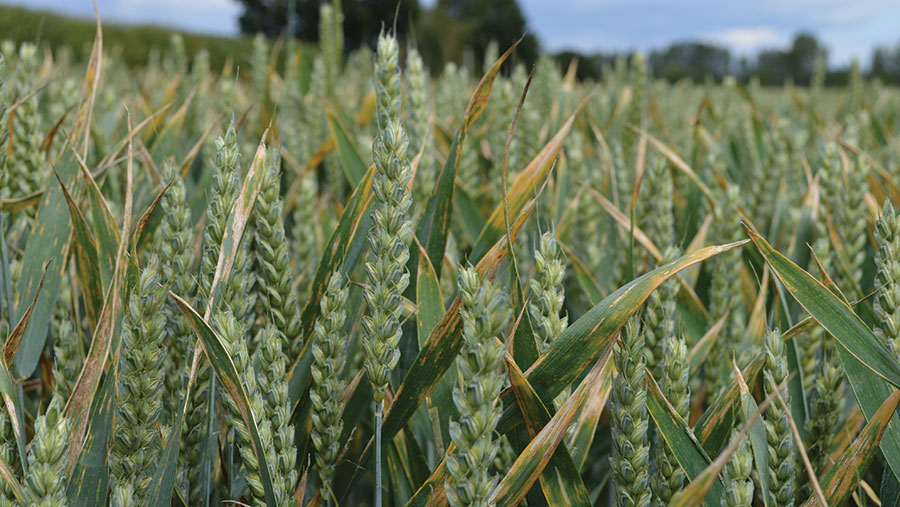
One big farming company is hoping that growing the more disease-resistant winter wheat variety Extase will help it fine-tune fungicide spending this spring.
Sentry grew 100ha of the variety last season and has tripled its area this year, as there is plenty of demand for the milling grain and it fits into the group’s preferred October drilling slot.
Extase, bred by KWS, achieved the highest yield in the AHDB Recommended List untreated fungicide trials, due largely to its good resistance to septoria and yellow rust, and seed is expected to sell well this autumn.
James Mayes, who advises Sentry on fungicide strategy and is farm manager at one of the group’s farms in Essex, is impressed with the new variety and the potential to push wheat fungicide costs below £100/ha.
“Our fungicide programme in a low-disease season can get down to £85/ha, and we expect Extase could be about that figure in a four-spray programme,” he says.
See also: Farmer trials disease strategies in wheat variety Extase
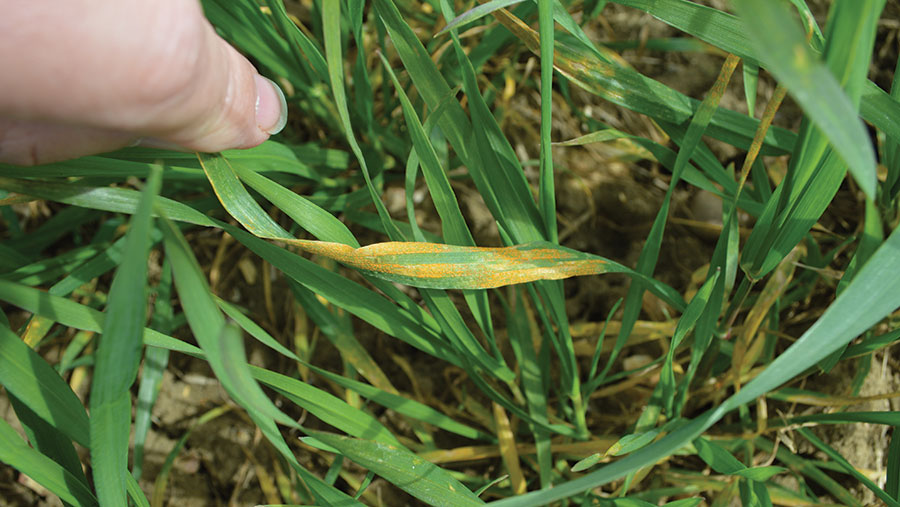
Extase has shown very good resistance to yellow rust
Promising yield
Last year, the group grew the variety on some of its East Anglian and Kent farms, and it developed quickly after October drilling, showed good vigour and yielded more than 10t/ha.
“We see it as a robust and flexible variety, with its good disease resistance helping with risk management for outlying blocks of land,” adds Mr Mayes from Bentfield Bury Farm, just north of Bishop’s Stortford, where he manages 800ha of arable land.
Overall, Sentry manages 20,000ha, stretching from Leicestershire, through East Anglia and Kent in the East, and across to Dorset in the South West, where it is more risk adverse due to a heighten disease threat.
With pressure as ever on profit margins, there is potential to make savings with Extase in a good year – not by omitting fungicide sprays, but by looking at the components, and the big opportunities will come at T0 and T1, he says.

James Mayes
Disease concerns
In the east of England, yellow rust and mildew tends to be more of a problem early in the season rather than the wet weather-loving septoria, so Mr Mayes looks to tailor T0 sprays to the disease risk.
For the T0 spray, usually in the last week of March, he favours a relatively inexpensive azole-mildewicide mix with epoxiconazole plus metrafenone (Ceando), and maybe chlorothalonil as a protective multisite.
This came under scrutiny this year, with growing a more disease-resistant variety balanced against the likelihood of more disease being around in crops.
“After such a mild winter, there is disease about and we will apply a T0, as it is also a good way of getting plant growth regulators and trace elements on to the crop,” he says.
Fungicide regime
For T1, Mr Mayes is looking at an economical approach using the first-generation SDHI boscalid for eyespot, epoxiconazole for rust (and both for septoria), and pyraclostrobin for rust and its greening effect (Nebula). Again, the multisite chlorothalonil is likely to be added.
For a T2 flag leaf spray, he is likely to use a range of SDHI-azole products, such as Ascra and the new Revystar and, hopefully, some chlorothalonil before it is banned for use from 20 May.
He looks to protect grain quality at the T3 ear spray with a mix of azoles such as prothioconazole, tebuconazole and prochloraz to control fusarium and late attacks of brown rust.
Actives
- Ceando Azole epoxiconazole + mildewicide metrafenone
- Nebula SDHI boscalid + azole epoxiconazole + strobilurin pyraclostrobin
- Ascra SDHIs bixafen and fluopyram + azole prothioconazole
- Revystar SDHI fluxapyroxad (Xemium) + azole mefentrifluconazole (Revysol)
Five winter wheats on the AHDB Recommended List with the top untreated fungicide yields |
||||||
| Variety | Untreated yield | Treated yield | Septoria | Yellow rust | Brown rust | Mildew |
| Extase | 95 | 101 | 8.1 | 9 | 7 | 6 |
| Theodore | 90 | 100 | 8.2 | 9 | 7 | 7 |
| Graham | 88 | 102 | 6.3 | 8 | 6 | 7 |
| Saki | 86 | 104 | 6.8 | 9 | 8 | 6 |
| Sundance | 85 | 100 | 7.9 | 9 | 6 | 7 |
| Yields are a percentage of control varieties, while disease resistance scores are on a 1-9 scale where 1 is susceptible and 9 shows good resistance. | ||||||
More leaf retention in Dorset
East Dorset grower Nigel Friend hopes Extase will lead to more leaf retention and, therefore, higher yields while he sticks with a four-spray fungicide programme.
He is looking for his second crop of the variety to top 10t/ha this season, with his later-drilled portion looking the best after a wet autumn. Septoria is his biggest disease problem, and he is reluctant to cut fungicide spending, even though the variety has a high resistance rating.
“Often, the more you spend, the more the crop yields, so we won’t be cutting our fungicide spend,” he says from his 200ha Lower Farm, Gussage St Michael, near Wimborne.
Mr Friend grows wheat as a break between herbage seed crops, and the 20ha of Extase he planted last year yielded 10.5t/ha which, although it is a milling variety, was below his five-year average of 11.5t/ha from feed varieties.
This year, he drilled 28ha of Extase in three blocks – at the end of September, end of October and end of November. The earliest-drilled area looks massively forward and the latter looks the best. “I will be looking for a yield of more than 10t/ha, but probably not as high as 11.5t/ha,” he says.
His fungicide bill tends to be about £100/ha, with the multisite chlorothalonil used at T0 – and often with the next three sprays – SDHI-azole at T1 and T2, and then strobilurin at T3. This season, the only likely change will be no chlorothalonil at T3 as it is banned after 20 May.
An agronomist’s view
Fungicide expert Bill Clark believes Extase growers should be targeting annual fungicide costs as little as £60/ha when growing the wheat variety.
The Group 2 milling variety gives the highest yield without the use of fungicide, ahead of Theodore and Graham (see “Five winter wheats on the AHDB Recommended List with the top untreated fungicide yields”), reflecting its good resistance to septoria, and yellow and brown rust.
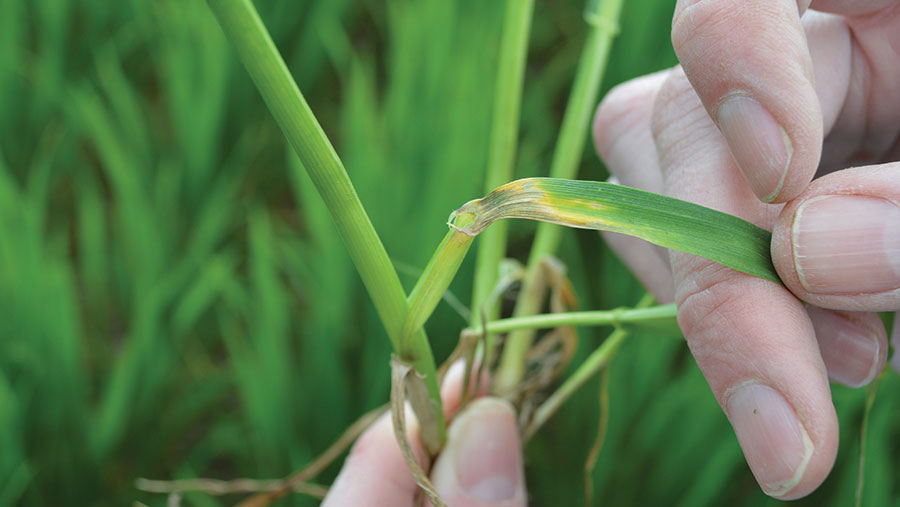
Early infection of septoria on wheat
Mr Clark, who is technical director at crop consultant Niab, says the group’s planning tool suggests a £50-£70/ha range of fungicide costs for Extase using just T1 and T2 sprays. “I firmly believe you can grow Extase with fungicide costs as little as £60/ha using a two-spray programme,” he says.
He suggests using an azole-SDHI-multisite mix at T1 for £25/ha and again at T2 for £35/ha, while a decision on a T3 should be taken separately depending on the season.
Many growers benchmark £100/ha for wheat fungicide costs, dipping below that in a low disease year and edging above in a bad disease year.
Extase has the second-highest septoria resistance score of 8.1, only beaten by Theodore’s 8.2. It scores a 9 for yellow rust and a 7 for brown rust – beaten only by Skyfall and Saki on 8 – on the AHDB Recommended List, where 1 is susceptible and 9 is good resistance.
A seed trader’s view
Extase could be the top-selling winter wheat variety in autumn 2020, just pipping Skyfall due to its good all-round disease resistance, with no obvious weaknesses.
Barry Barker, national arable seed product manager at agronomy group Agrii, says the Group 2 milling variety could take 12-15% of the certified seed market this autumn.
This takes up 55% of the total market, with the rest from farm-saved seed.
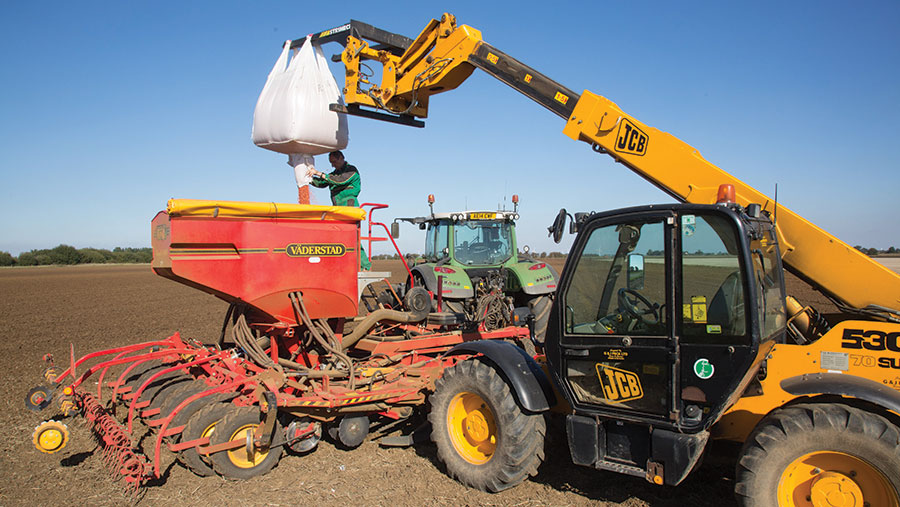
Extase could be the top-selling wheat variety this autumn. © Tim Scrivener
“It will be a toss-up between Extase and Skyfall for the top spot, and Extase might just beat Skyfall, with Gleam in third spot,” he says.
Milling variety Skyfall has been the top seller for the past few years, and has been popular this season due to its flexibility to drill late after a wet autumn, while Gleam is a high-yielding feed wheat.
Extase is the highest-yielding of the Group 1 and 2 milling varieties in fungicide-treated trials at 101%, along with Siskin.
It is as early to mature as Skyfall, has good grain quality, strong disease resistance and a straw strength stronger than Siskin, but not quite as stiff as Skyfall.
Extase has stood up well with its good resistance to wet-weather disease septoria, but he warns growers that they will not be able to save a lot of money on fungicides.
“It’s not a variety that you can shut the gate on, and it will need managing like any other variety,” he says.
A miller’s view
One of Britain’s biggest millers, Heygates, is keen on Extase, due to the wheat variety’s earliness to maturity and its good disease profile.
George Mason, senior executive at the milling group, says the company is offering buy-back contracts for this harvest and for the variety in the future.
“We like the variety for three reasons – its high untreated yield, good disease profile and earliness to mature,” he says.
The group is supporting the variety, as it needs fewer fungicide inputs, which will be useful for growers when an increasing number of actives are being restricted.
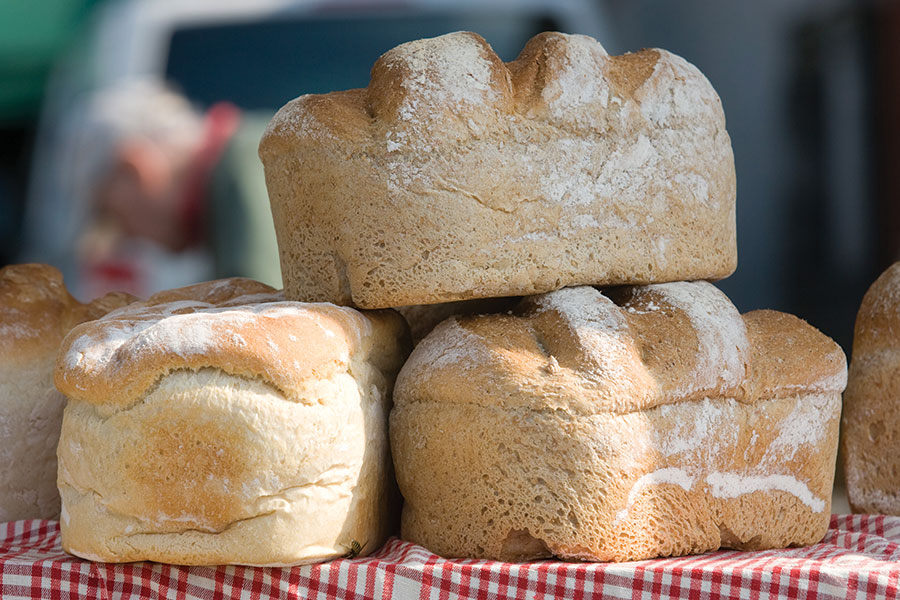
© Tim Scrivener
The price for the Group 2 milling variety’s buy-back contract is being set just below Group 1 varieties aiming at a standard quality of 13% protein, 250 hagberg and 76kg/hl, but taking grain down to 12-200-74 at a lower price.
The wet autumn has seen a smaller wheat area planted, with the AHDB Early Bird survey estimating a crop down 17% at 1.5m hectares. The wheat harvest is forecast at about 11m tonnes after 2019’s 16.3m tonnes.
The milling industry uses about 5m tonnes of wheat annually, and with a lower overall wheat harvest forecast, millers may have to use more Group 2 varieties and imports from countries such as Germany.

